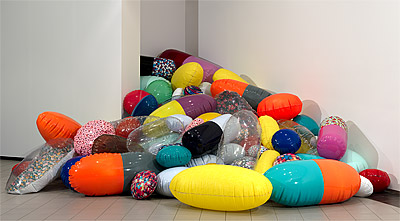Christopher
LANGTON
South Africa
1954
Australia from 1973
Sugar the pill
1995/2009
polyvinyl chloride
dimensions variable
Collection of the artist
Plastic is cheap, lightweight, flexible, ubiquitous and politically unsound—a synthetic material, derived from petroleum. Formed by industrial methods, with limited application to craft and handforming techniques, it is a perishable material best suited to mass production of cheap consumer goods. Plastic is a material of the kitsch object—a debaser of the ideals of high culture and high art.[1]
Christopher Langton uses plastics technology initially developed for the aeronautic industry.[2] The introduction of high-frequency PVC welding in the 1960s―allowing sheets to be joined with thin, air-tight seams—resulted in a huge increase in the number and types of inflatable items produced.[3] Claes Oldenburg, Jeff Koons, and especially Japanese and Korean artists subsequently employed pneumatics to a remarkable range of effects.[4] Looking at Langton’s sculptures, however, it is mass-produced toys, blow-up pools, beach balls and jumping castles that come to mind. Kitsch, sugary and sometimes spooky, irresistibly consumerist and undeniably desirable―we can’t help but want to join in the fun.
Langton’s oversized toys and other objects are bright, overwhelming and often of frightening proportions. They loom over us, crowd into our space, ignoring the traditional distance between art and viewer. Sugar the pill was originally installed in the basement of a nineteenth-century apothecary’s shop, arranged as if tumbling out of a dispensary. The architectural setting of Sugar the pill may thus be imagined as standing in for the body. The artist has remade components for the 2009 installation—a few repairs were necessary, and he also took advantage of more sophisticated techniques—and some pills are now more colourful, or composed of multiple capsules. From the classic 1960s ‘mother’s little helpers’, to an age when a plethora of substances in capsule form is available to combat anything from weight-gain to depression, we sense that the element of fun masks darker meanings. A spoonful of sugar does indeed make the medicine go down.
Lucina Ward
Curator,
International Painting and Sculpture
National Gallery of Australia, Canberra
[1] Christopher Langton, artist’s statement in Rapport: eight artists from Singapore and Australia, Monash University Gallery, Monash University and the Asialink Centre, Melbourne, and Singapore Art Museum, 1996, p 24
[2] The development of pneumatic technology and inflatable design, from the first hot-air balloons in eighteenth-century France, to early twenty-first century applications, is explored by Sean Topham in Blowup: inflatable art, architecture and design, Prestel, Munich/Berlin/London/New York, 2002
[3] Inflatable structures increasingly had design applications in the 1960s and 1970s, with the Blow chair being one classic example; it was designed in 1967 by Gionatan de Pas, Donato D'Urbino, Paolo Lomazzi and Carla Scolari, and from 1968 manufactured by Zanotta s.p.a., Nova Milanese
[4] In Soft sculpture, for example, see Choi Jeong Hwa’s giant clear lotus

